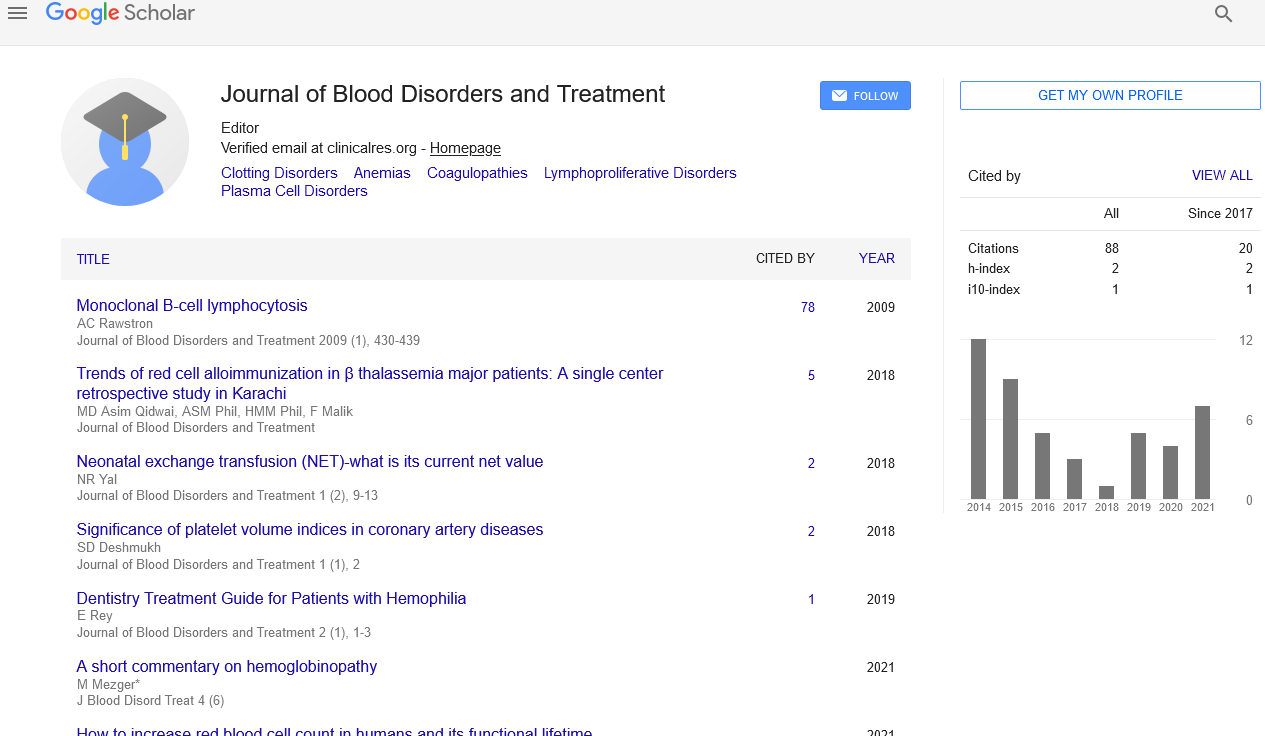Plasma cell: Advances in health and disease
Received: 09-May-2022, Manuscript No. PULJBDT-22-5121 ; Editor assigned: 11-May-2022, Pre QC No. PULJBDT-22-5121 (PQ); Reviewed: 19-May-2022 QC No. PULJBDT-22-5121 (Q); Revised: 21-May-2022, Manuscript No. PULJBDT-22-5121 (R); Published: 29-May-2022, DOI: 10.37532/puljbdt.2022.5(3)25
This open-access article is distributed under the terms of the Creative Commons Attribution Non-Commercial License (CC BY-NC) (http://creativecommons.org/licenses/by-nc/4.0/), which permits reuse, distribution and reproduction of the article, provided that the original work is properly cited and the reuse is restricted to noncommercial purposes. For commercial reuse, contact reprints@pulsus.com
Abstract
A variety of conditions known as plasma cell dyscrasias include the monoclonal proliferation of lymphoplasmacytic cells in the bone marrow and, sporadically, the deposition of monoclonal immunoglobulins or their constituent parts in tissue. Multiple Myelo- -ma (MM), Waldenström's macroglobulinemia, and other uncommon ailments including Light-Chain Deposition Disease (LCDD) and Heavy-Chain Diseases (HCDs) are among the disorders. Light-chain amyloidosis is a plasma cell dyscrasia and is one of a set of tissue deposition illnesses referred to as amyloidosis. Asymptomatic laboratory abnormality monoclonal gammopathy of unclear significance may develop.
Key Words
Monoclonal; Gammopathies; Immunization
INTRODUCTION
The evaluation of the clinical burden of plasma cell infiltration, the examination of radiographically visible bone lesions, the electrophoretic determination of the monoclonal immunoglobulin, and the evaluation of plasma cells in the bone marrow or extramedullary tissue are all necessary for the diagnosis of plasma cell dyscrasias. Magnetic resonance imaging of bone lesions, immunophenotype detection of aberrant surface antigens on plasma cells, molecular characterization of clonally rearranged immunoglobulin genes, and an expanding spectrum of cytogenetic abnormalities enhanced by fluorescent in situ hybridization technology are recent developments and technological advancements in the detection of plasma cells pathology.
Because the Plasma Cell (PC) was only functionally recognized in the middle of the 20th century, it is still a relatively young cell type in biomedical science. PCs are highly specialized immune effectors with terminal differentiation that produce and secrete antibodies, the effector molecules of Humoral Immunity. PCs originate from B cells after infection and immunization. Serological memory is made possible by the longevity of protection offered by circulating antibodies, which can endure in the absence of antigen. PCs have long been believed to be transient and to continuously differentiate from B cells to maintain serum antibodies due to their quick departure in circulation. Recent research has shown that decades after an antigen contact, PCs may continue to function and secrete protective antibodies.
The molecular mechanisms governing PC production from shortlived Antibody Secreting Cells (ASC) and the source of the stimulus that initiates this change remain unknown. Long-lived PCs (LLPCs) are primarily found in the Bone Marrow (BM) and exist in specialized habitats. PC survival niches are shaped by a combination of many cell types and signals. LLPCs in humans are now classified as CD19neg, CD138+ and CD38hi, but there is likely phenotypic, biochemical, and functional variation within this group. LLPCs are anything but dormant; instead, they exhibit unmatched Immunoglobulin (Ig) secretion that necessitates special organelle organization as well as adaptive proteostasis and metabolic properties that pique intense interest and provide significant research hurdles. Targeting such multi-cellular environmental niches has considerable therapeutic potential against myeloma, but further research is necessary to acquire a thorough understanding of the underlying circuits. With a detailed focus on the myeloma-causing genetic and epigenetic alterations in the context of PC differentiation and biology, on clonal gammopathies and their interconnection with the expanding knowledge of PCs in their discussion of the cellular and genetic origins of multiple myeloma. IgE PCs develop to fight against parasites, but they can also play a role in allergic disorders. To examine the transcriptional patterns of IgE-expressing PCs. They discovered probable unique gene expression trajectories and regulatory networks.
This series is completed with two further unique articles. PCs serve purposes other than secreting Ab. the role of PCs to IL-10 supply in the BM using mouse models. They examined its functionality and showed that IL-10 played a critical role in promoting myeloid lineage differentiation, and an impact that appeared to get stronger with age. They also confirmed PCs as the main source of IL-10. Last but not least, the surface immunophenotypic markers used to distinguish antibody-secreting plasmablasts in Chinese rhesus macaques, nonhuman primates. This research may aid in the isolation of ASCs for effective mAb cloning and the evaluation of antibody responses to infection or immunization in these human-relevant animal species.





